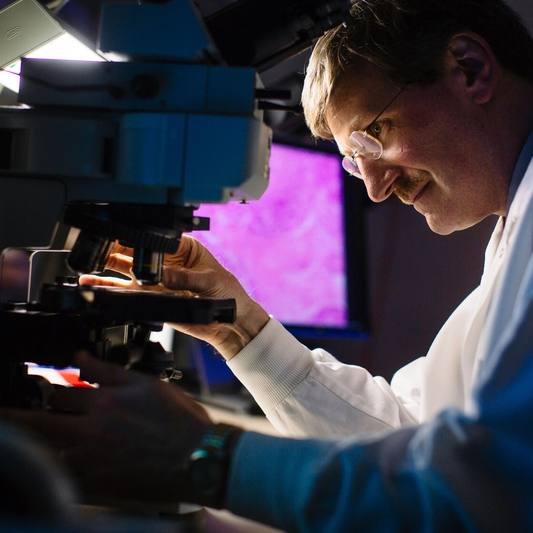-
Research
Science Saturday: An anti-cancer establishment
In Shakespeare's time, medicine was based on the Hippocratic theory of the four bodily humors, or fluids. Good health was all about keeping these humors in balance, and it was understood that everyone was different. In a sense, today's individualized medical approaches are cycling back to the understanding that we're all unique. Hepatobiliary tumors — abnormal growths of the liver, gallbladder and bile ducts — are a leading cause of cancer worldwide, according to the American Cancer Society. But distinctive information about each patient and tumor can make all the difference.
SPORE research
Across the U.S., the National Cancer Institute supports more than 60 Specialized Programs of Research Excellence (SPOREs), each focusing on a specific group of related cancers. SPORE grants are like rocket fuel for translational cancer research, helping findings move quickly from the basic science laboratory to patient care. Understanding the need for that kind of propellant behind hepatobiliary tumor research, gastroenterology researchers Mark McNiven, Ph.D., and Lewis R. Roberts, M.B., Ch.B., Ph.D., successfully brought a hepatobiliary SPORE to Mayo Clinic and now act as principal investigators for the new program.

"What's particularly exciting for us," says Dr. McNiven,"is that it's the only SPORE focused on liver cancers in the country."
Their hope is that heightened attention will soon stimulate wider research into the deadly cancers. The SPORE has four main translational research projects, each with multiple lead investigators and many research team members.
One project, based at The Rockefeller University in New York City, focuses on fibrolamellar carcinoma, a type of liver cancer that strikes teens and young adults. This team, led by Sanford Simon, Ph.D., of The Rockefeller University and Michael Torbenson M.D., of Mayo Clinic is identifying molecules and genes that drive tumor formation. Then they use imaging techniques to track changes as the tumors grow, striving to improve diagnosis and treatment approaches.
The other three projects are based on Mayo Clinic's Arizona, Florida and Minnesota campuses.
On Mayo Clinic's Florida campus, cancer researchers Tushar Patel, M.B., Ch.B., and John A. Copland III, Ph.D., are starving cancer cells by blocking lipid metabolism.
"Cancer cells have a high energy burden because they are continuously dividing," explains Dr. McNiven. And this can be exploited as a weakness. The goal is to use this approach to augment other therapeutics — a double left hook to multiple types of hepatobiliary tumors.
In a project spanning Mayo Clinic's Arizona and Minnesota campuses, oncologist Mitesh Borad, M.D., and immunologist Richard Vile, Ph.D., the Richard M. Schulze Family Foundation Professor, are collaborating with Dr. Roberts on immunotherapy for hepatocellular carcinoma, the most common primary liver cancer. They're using a virus that preferentially infects and kills tumor cells, in part by stimulating immune responses against them.
And in Minnesota, gastroenterologist Gregory Gores, M.D., and surgeon Rory Smoot, M.D., are studying the nuts and bolts of how cancer cells escape programmed cell death (a normal mechanism of cell cycle regulation). They're working to develop new therapeutics for cholangiocarcinoma, a lethal bile duct cancer.

Banking samples and making the most of them
The liver is the second-largest organ in the body. It has the heft of a cantaloupe, if you can imagine that, while the pancreas is more like a banana and the gallbladder like a lemon. All are linked to one another along the biliary tree — a system of ducts that direct bile from the liver and gallbladder, and digestive enzymes from the pancreas, to the small intestine.
The cells of these organs are susceptible to becoming particularly deadly tumors. In his laboratory, Dr. Roberts focuses on identifying and understanding the ways they progress. "As you study [these] cancers, you see that there's a gradient," he says. Primary cancers that start in the liver are generally slower-growing. But when cancers start further down the biliary tree, closer to the pancreas, they tend to be more aggressive.

Hepatocellular carcinoma occurs most frequently in people with chronic diseases, such as hepatitis B or hepatitis C infections that have caused liver scarring (cirrhosis). For this reason, "liver disease is quite common in Africa, especially sub-Saharan Africa," says Dr. Roberts, who was born and educated in Ghana. "When I was in medical school, I took care of a number of very young people with liver cancer."
At about that same time, on the other side of the world, Mayo Clinic liver surgeon David Nagorney, M.D., was likewise certain that the solution to this health crisis would not lie solely in the operating room. Dr. Nagorney began freezing samples from every resection.
"So 20 years ago when I started on faculty at Mayo Clinic, he passed on a collection of 10 years' worth of samples," explains Dr. Roberts.
Now as part of the new SPORE, Dr. Roberts is building on this legacy by developing a world-class biobank for hepatobiliary specimens.
With reposited samples and data, research doesn't have to wait for specimen collection. It moves full steam ahead. Also, samples can be reaccessed as techniques improve and biological understanding expands. Sometimes the key is knowing what to look for. To accomplish this, the new program also has a statistics and informatics core to analyze and interpret the large data sets being mined from biobanked samples.
Hepatitis and liver cancer
Unexpectedly, Dr. Robert's commitment to reducing hepatitis and improving liver cancer outcomes on his home continent is supported by Minnesota's Somali community, which is the largest in the U.S.
As more than a quarter-million people died in a famine in Somalia between 2010 and 2012, hundreds of thousands fled — many to Rochester. A few years later, Abdirashid Shire, Ph.D., himself a member of the Somali diaspora, joined Dr. Robert's team as a postdoctoral fellow.
"Once they found out that he had a Ph.D. and was working at Mayo, people from the community began contacting him and saying, you know, 'I have hepatitis,' or 'my uncle has liver cancer,' and 'is there anything you can do to help us,'" Dr. Roberts explains. Thus began a series of studies to learn about hepatitis rates in the immigrant Somali community and how the infection leads to tumors.
Most people do not know that they have hepatitis until they are diagnosed with cancer, but for Mayo Clinic patient Kaiyu Chen, the opposite occurred. His hepatocellular carcinoma was found while he was being treated for hepatitis B. Dr. Chen, a mechanical engineer originally from China, began chemotherapy near his home in Cincinnati. Unfortunately, little headway was made and his tumor stopped responding. His oncologist referred him to the Mayo Clinic Cancer Center, where he was treated by Dr. Roberts for about a year before being transferred to the Transplant Center. He received a new liver just a few months later. "I was lucky," he says. After surgery, he spent about six weeks in the Gift of Life Transplant House, working remotely on his laptop while he convalesced.
"There's something really special about Mayo," says Dr. Chen. "It made a big difference in my recovery. During my whole treatment, I had confidence and trust in them."
Launchpad for discovery
If Dr. McNiven and Dr. Roberts have their way, the need to refer patients for transplants will be supplanted.
In his laboratory, Dr. McNiven studies how mechanisms used by healthy cells to take care of everyday functions can get hijacked and used by cancer cells to mechanically invade peripheral tissues, or metastasize. The Hepatobiliary SPORE identifies Mayo Clinic as a premier center for the study, and prevention and treatment of liver cancers — not only directly through its own translational research projects, but also by underpinning basic research such as Dr. McNiven's that advances the understanding of how these cancers develop and spread. Ultimately, treatment effectiveness will be determined by what makes each patient's cancer unique.
— Megan McKenzie, January 2019







